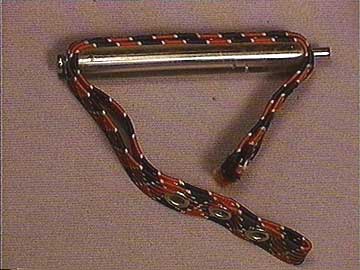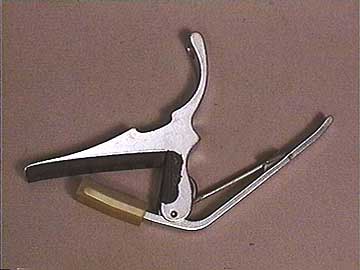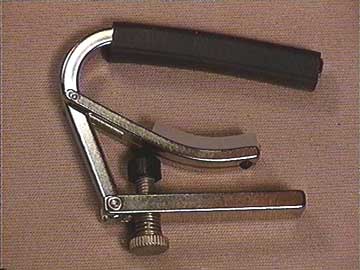Page 1 of 3
Reinventing the wheel
The Capo, Now and Then
© Frank Ford, 1/7/99; Photos by FF, 1/6/99
The ubiquitous capo!
For generations, it has been the most useful accessory for players of guitar and
other fretted instruments.
Simply a device to hold all the strings down at one fret position to raise the pitch
of the instrument, the capo comes in a variety of styles from plain and simple to
elegant and sophisticated.
In its simple form, the capo is just a padded bar with an elastic strap to apply
the tension:

This kind of capo has been the simple inexpensive mainstay for many decades. If you're
prone to losing things, or just getting started playing guitar, it's a logical choice.
This spring clamp kind has bulky looking handles:

No problem, though, because it's designed so the handles are never in the way!
Like the spring clamp, this cam lever capo can be used with one hand:

There are dozens of other capo styles on the market right now, but I won't try to
enumerate them all. Capo choice is a matter of personal taste, and most of them will
work quite well, if you use them correctly.
In use, the capo should sit directly behind the fret, as close to the fret as possible:

Ideally, the downward pressure should be just enough to hold the strings against
the fret without buzzing or rattling. That way the capo won't press the strings so
hard that they stretch out of tune very much.
Any capo is bound to affect intonation because the strings are stretched as they
are pressed to the fret. A capo placed way back behind the fret will stretch the
string more than one placed close to the fret. Place the capo right on top of the
fret, and you'll avoid stretching the string, but you'll lose tonal brightness and
clarity.
Most modern capos are available in different "shapes"
to accommodate different fingerboards. Short bar capos fit the narrow necks of banjos
and mandolins. Curved bar capos are necessary for the radiused fingerboards of steel
string guitars, and flat bar capos are the best for the flat fingerboards of classical
guitars.
Even the most exotic capo is a relatively inexpensive accessory, so many guitarists
buy and try a bunch of different styles to find the one that works best for them.
The capo (nicknamed "cheater") has something of a bad rap as a crutch
for poor technique Yes, jazz and other styles of playing require sophisticated technique,
and experienced players of these styles don't use capos. But there are lots of styles
of playing that require the use of open strings, and to play in various keys, a capo
is necessary no matter how skilled the musician.
On each of the next two pages, I present a little gallery of vintage capos, some
recent, some quite old. Some of the more recent capos may still be in production,
some have been discontinued. These photos are only a small sampling of the staggering
array of capo styles that are or have been available.
More
1
2
3
Back to Index Page



